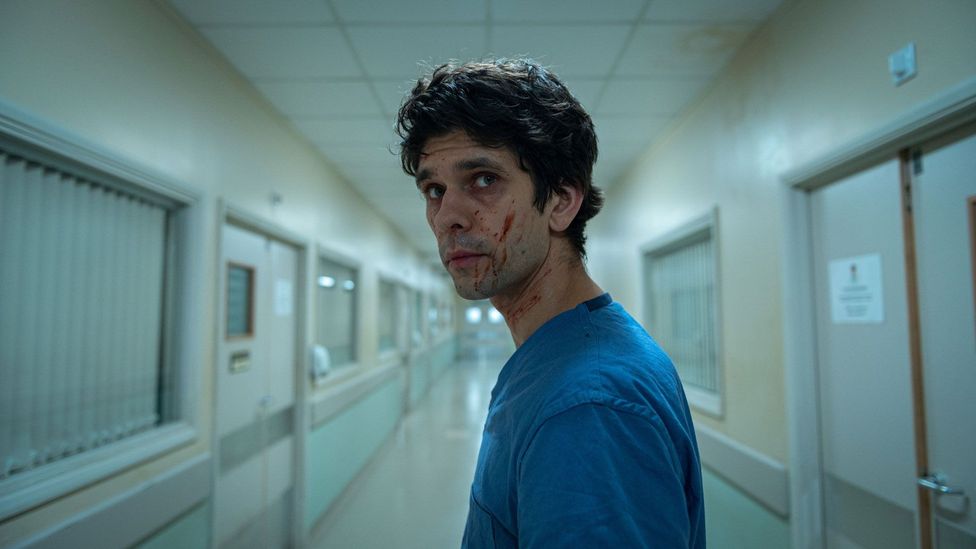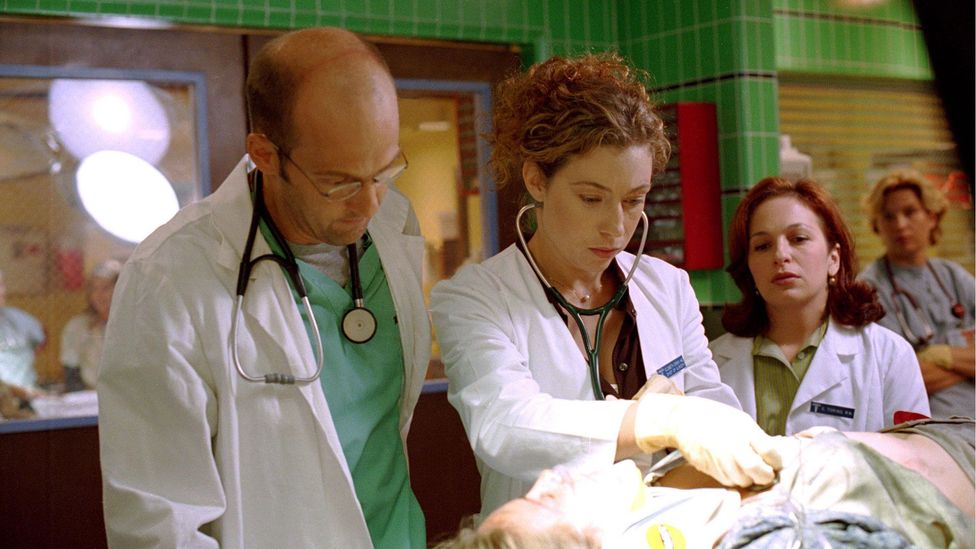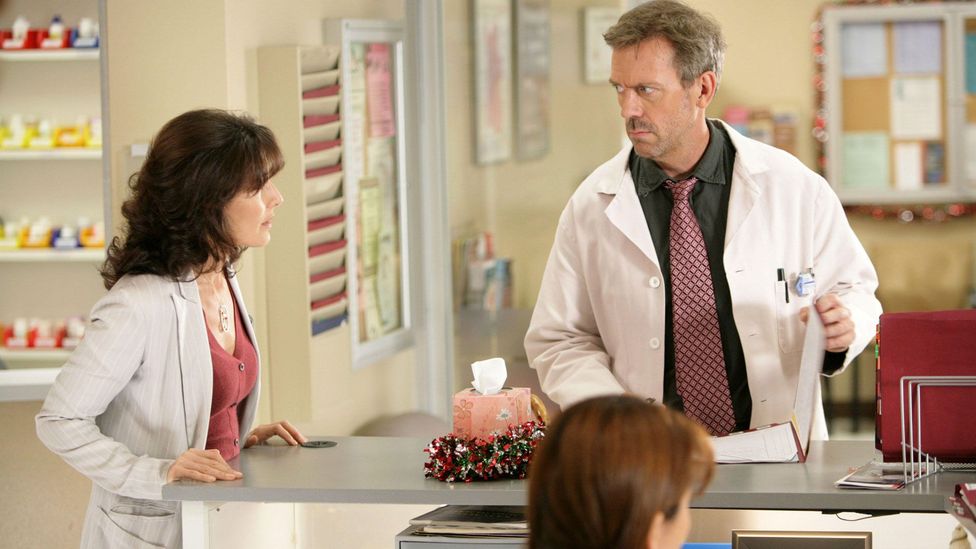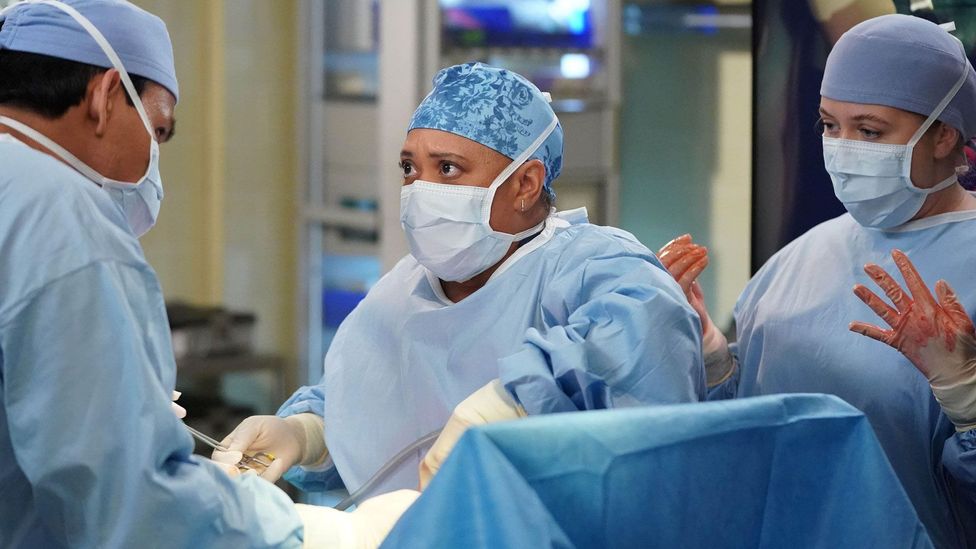In a Chicago hospital, two doctors are leaning over an unconscious patient, trying to work our what's wrong with him. The senior resident looks at his chart. "Partially compensated metabolic acidosis," he observes. They take the man's temperature, and examine his tongue, finding evidence of abrasion and a seizure. "Meningitis?" wonders the trainee.
"Yeah, could be. We're going to have to do a lumbar puncture. You ever done one?" the senior doctor asks. "Uh no, but I've seen it done…" "See one, do one, teach one", says the senior doctor. The trainee's eyes widen as he realises he's going to have to tap someone's cerebrospinal fluid for the first time.
More like this:
– TV shows to watch this February
– What is the future of the cop drama?
– Netflix's fake heiress drama is a hit
So goes a conversation between resident Mark Greene (Anthony Edwards) and his junior John Carter (Noah Wyle) in the first season of ER, the 1990s medical drama that spawned many imitators for its realistic depiction of hospital procedures – including lumbar punctures.

New series This is Going to Hurt is based on former doctor Adam Kay's book about his experiences as a junior doctor (Credit: BBC/AMC)
Greene's phrase – "see one, do one, teach one" – sounds like it was coined in the ER writers' room, but it's a real teaching method for training students and junior doctors. It was one example of how ER's producers managed to integrate a verisimilitude lacking from many soapier medical shows, such as the long-running series General Hospital.
I heard the "see one, do one, teach one" line once again more recently, in the first episode of the new BBC and AMC drama This is Going to Hurt, a punishingly funny portrayal of a British doctor's life on an overworked and underfunded maternity ward in London. Following a morning from hell, the doctor Adam Kay (Ben Whishaw) is asking a naïve trainee (Ambika Mod) if she has ever performed a caesarean section. No, she hasn't, she says, but she's observed one. "See one, do one, teach one," Kay replies. And sure enough, soon they are both in surgery.
In its setting, procedures and emergencies, This is Going to Hurt has the same authentic dialogue and realism that runs as a thread through many medical dramas these days. Where it aims to differ from others in the genre, though, is in its depiction of just how exhausting and personally consequential it can be to work as a junior doctor in the UK's free-at-the-point-of-use National Health Service. It also features some extremely rude British doctor-humour that you'd never hear from ER's George Clooney.
Does this kind of irreverence make This is Going to Hurt more "real" than its predecessors? Certainly, it feels like it offers a fresh perspective – but then, like any medical drama, there are still some aspects of hospital life that it cannot show. Watching the series, the question it begs, like so many medical dramas before it, is: to what extent is it possible to depict "real" medicine on screen – and what typically goes missing in the translation?
Blurred lines
TV medical drama has always blurred the line between truth and fiction. The genre can be traced back to the 1950s, with US shows such as City Hospital, and Medic. Even then, writers were deploying tricks to amp up the realism. Medic opened with a short introduction by an apparently real doctor (it was an actor) who described the affliction or disease underpinning the story that followed, as if it was a case study in a scientific lecture. It also featured a dedication to "the profession of medicine, and the men and women who labour in its cause".
Over the following decade or so, producers across various medical shows employed – and advertised – their use of medical consultants to supposedly lend expertise. These advisors continue to offer pointers to writers to this day – with arguably mixed results. In practice, it is often more about fact-checking specific medical claims rather than screening out unrealistic plotlines.
Plenty of medical dramas since then may seem to have dispensed with realism, embracing ever-wilder and soapier storylines. But at the same time, TV writers have long known that rooting their fiction in apparently true-to-life medicine lends their stories extra resonance – and the real world has continually offered new sources of inspiration too. The medical literature is full of extraordinary case studies that need only be lightly fictionalised to work as entertainment, and every doctor or nurse has at least one story about a patient that would be ripe to be televised.

ER set a new standard for realism in TV medical drama – but it still had a real-life doctor contemplating legal action for its inaccuracies (Credit: Alamy)
In the mid-1990s, the US show ER took authenticity one step further. Entwined with its stories of romance and conflict, the drama depicted a hospital emergency room facing the social problems of its inner-city location in Chicago, with a camera that did not shy away from the grisly and bloody details of the wounded or the ill. The writers also introduced complex medical jargon into the scripts, making few concessions to the non-medically trained audience – nor, for that matter, the actors. To help him remember all the arcane medical vocabulary, Clooney – playing the character Doug Ross – apparently wrote his lines on patients' bedsheets or his clipboard, out of view of the camera.
ER was so apparently authentic that it began to feed back into the teaching at medical school: educators would play clips from the show in classes to teach students about effective patient interaction. As the doctor Ellen Lerner Rothman wrote in a memoir about her training at Harvard Medical School, ER was hugely influential for her and her fellow students: "Through the ER physicians, residents, and medical students, my classmates and I explored who we wanted to be and what we were afraid we might become. We developed a paradigm for how we wanted to respond to our patients and explored how we would feel if we were unable to uphold it in the real world."
That said, ER might have had the jargon and realistic gore, but the stories were not completely true to life. The departures from reality ranged from the benign to the fantastical. Like all medical dramas, the writers had to use time compression to make patient arcs fit into a single episode: the results of blood tests, for example, normally take days to come back, not hours. Single doctors performed an array of tasks that would, in reality, be shared between a team; patients disproportionately survived cardiac arrests, trainees led complex surgeries, and the actors unwittingly did things like mishandling blood samples that would make for a careless infection risk. And then of course there were the movie-star good looks and helicopter crashes right outside the hospital front door.
Indeed, soon after ER premiered in 1994, the producers decided to change the name of the fictional Chicago hospital it was set at from Cook County General hospital to simply "County General", after the head of emergency medicine at Chicago's real-life Cook County Hospital complained to the showrunners and investigated legal action, so annoyed was he at the show's inaccuracies.
Of course, ER has been far from alone in its departures from real life. Some medical dramas have gone quite a bit further. Grey's Anatomy would be one example of a show where no viewer could ever believe they were watching events from a real hospital. At least, you would hope so: plotlines include the time Cristina (Sandra Oh) got impaled by a falling icicle outside the hospital, or the notorious musical episode when the characters broke into song. The writers, however, have drawn on real-life medical case studies for their stories. Episodes where Meredith Grey (Ellen Pompeo) and her colleagues encounter a girl immune to pain, or a woman who had several spontaneous orgasms per day were based on accounts of real patients.
Where TV writers have really taken liberties, though, is over the depiction of doctors' professionalism, or lack of it. A team of medical researchers led by Lindsey Ouellette at Michigan State University recently watched 271 episodes of primetime hospital drama, including ER, Grey's Anatomy, House, Nurse Jackie, and 12 others, and observed more than 1,000 individual examples of unprofessional behaviour among the fictional doctors and nurses in the shows. "Although TV dramas often promoted emergency medicine clinicians as heroes acting in the best interests of their patients, the episodes also offered story lines in which physicians were morally corrupt, racist, arrogant and uncaring toward each other, staff, and patients," write Ouellette and colleagues.
Another study, focusing on House and Grey's Anatomy, was similarly critical, finding "egregious deviations from the norms of professionalism" in the storylines. These included the failure to get consent from patients for treatments; the fact that many of the physicians were in some sort of sexual relationship with one another; and a litany of disrespectful interactions between colleagues that would normally land the doctors in trouble with HR. Perhaps unsurprisingly, Gregory House (Hugh Laurie) was the main culprit of the latter in his show, responsible for 88% of insulting or unprofessional encounters with colleagues and patients.
It may seem like these researchers were missing the point – because, after all, if TV protagonists did everything by the book, it would be rather boring to watch. But the reason they conducted the studies was their worry that inaccurate depictions on screen could spill out into how people see doctors and nurses in real-world care. "The scripts of these shows use technically accurate terminology, creating a greater sense of authenticity," write Ouellette and colleagues. "Because these shows appear realistic in many respects, the line between fact and fiction is blurred."

Hugh Laurie's Gregory House was one of the most famously unprofessional TV medics (Credit: Alamy)
Whether bad behaviour on screen is actually so big a problem, however, is unclear. Surprisingly, there is some evidence that watching medical dramas might actually enhance viewers' trust in real-world medical staff. And it might be argued that medical dramas, collectively, can inform audiences about the workings of worlds that they might otherwise not encounter unless they are ill, helping to humanise the doctors and nurses that work within them.
Pressure viewing
In terms of humanising the realities of hospital life, watching This is Going to Hurt certainly worked for me. It's a type of medical drama more rarely seen on screen: for one thing, it shows just how unflinchingly exhausting and thankless the job of a medical professional can be. In more conventional hospital dramas, the antagonists are usually colleagues, patients, disease or the wounded body – these are all present, but the primary foe that Kay is up against is the healthcare system itself. Under-funded and under-staffed, it threatens to drain everything from those toiling within it. There's not a hint of glamour or nobility to this work.
The viewer lands in Kay's visceral world almost immediately. He wakes up unshaven and exhausted in his car outside the hospital, before stumbling in late for work. Straight away, he encounters a woman in deep pain down an alleyway on the hospital grounds, experiencing an umbilical cord prolapse. Minutes later, he is kneeling over her as she is wheeled to an emergency c-section, calling for help from nurses and doing what he can to save her baby's life.
"Generally you're sailing the ship alone," Kay explains in a moment of introductory exposition. "A ship that's massive and on fire and no one's had the time to teach you how to sail. It's literally life or death here. You're constantly being splashed by bodily fluids – not even the fun kind."
The chaos continues throughout his shifts, with a tired Kay at various points insulting patients, botching procedures, and making poor medical judgements. All the while, he's managing relationships on the outside that he's too exhausted and time-poor to give his attention. One moment, he's inserting a scalpel into flesh; the next he's on the phone to his partner and a friend, promising that he'll fulfil his commitment to attend a stag do that evening. As Kay's mates booze it up in a pub, cajoling him to come join them, they seem totally detached from the realities of his work.
So is This is Going to Hurt more real than other medical dramas? It's difficult to tell. What makes the layers of truth and fiction more difficult to unpick is the show's writer. It draws heavily on the experiences of the real Adam Kay – the former doctor who wrote the script, which in turn was based on Kay's 2017 non-fiction book about his actual experiences in the NHS. Readers will recognise many of the same scenes, patients and jokes.
When a journalist in 2017 asked Kay about whether the events in his book were true, he said the stories were "reasonably accurate". Total truth, he explained, would have been unethical. It's also worth pointing out that Kay's NHS is more than 15 years old, based on experiences dating back to 2006.

Grey's Anatomy is among the medical dramas that has centred the pandemic in its narratives (Credit: Alamy)
In the translation to television, Kay has surely had to make concessions that depart from a truly realistic depiction of an NHS hospital in the present day – or at least, his own experience. Unlike the book, which is written in fragmentary diary entries spanning many months, Kay's experiences are woven together into episode-long arcs. The anecdote-and-punchline style of the book is gone, and therefore different patients are glued into single people. Notably, too, some of the book's sharpest doctor-humour has been toned down for mainstream television. Not much – it's still very rude – but a little.
Missing nihilism
Kay is of course not the only doctor who has adapted their medical experience for the screen. I asked the screenwriter Dan Sefton, a still-practising doctor, how he translates what he knows about medicine into fiction. He doesn't write memoir like Kay, but as a TV writer and co-founder of the production company Seven Seas, he has occasionally weaved his lived experience into various UK medical dramas, including The Good Karma Hospital, Trust Me, and episodes of Casualty, Doctors and Holby City.
What does he think is missing from hospital drama? His answer surprised me, because it had little to do with issues like medical accuracy or professionalism.
"The experiences that have stuck with me most profoundly as a doctor is the sheer nihilistic pointlessness and unfairness of it. That there is no reason, no meaning, for why somebody gets sick and dies," he explains. "If you tried to portray the reality of it, the cold reality, nobody would want to see it."
Most medical dramas, he continues, offer an antidote to that bleakness of real life. "They're trying to make even death seem meaningful. The ones that are successful, or at least, the emotionally warm ones, are about making sense of these painful experiences and trying to build them into a narrative.
Daniela Lamas, a doctor and screenwriter, reached similar conclusions when she wrote for the US series The Resident. "At first I worried that I made the televised version misleading," she recalled in the New York Times. "But the authentic core of uncertainty – how we balance risk and benefit and the great complexity in making decisions about allocating a limited resource – is still there. And I like believing in an alternate reality where my patient might have lived. This was the world we had hoped for. And in the writer's room we were able to make that world come to life.
"Television finds a way to offer enough reality to teach and to provoke, but also offers a balance. Viewers can come close to the fire but they are not scorched."
Sefton also points out that audiences come to mainstream medical dramas with certain expectations of doctors, which can influence the characters that writers choose to create or not. For example, it's rarer to see a fictional doctor or nurse who is not seeking to heal. Even House, for all his anti-hero flaws, was trying to save people's lives. "The idea that your doctor is not a selfless sort of saint, who's got your best interest at heart all the time and who goes home worrying about you…that's quite disturbing," says Sefton. "I think people find the idea of doctors not being perfect really very threatening."
Despite this, Sefton wonders whether, post-Covid, there may now be space for more nuanced depictions of hospital life, like This is Going To Hurt. The pandemic, he suggests, has also opened a lot of people's eyes to the pressures on health systems like the NHS. "The truth about the NHS is that it is a poorly-funded adequate health service, from a global perspective," he says. It's neither the best health provision in the world, nor the worst. "The sad truth is somewhere in the middle: extremely good value, kept going by lots of hard work by some dedicated people."
The pandemic's impact on US hospitals already seems to be feeding into the plotlines of American medical drama. A recent scientific study of 60 episodes of The Good Doctor, Grey's Anatomy, Chicago Med, The Resident and New Amsterdam aired between November 2020 and May 2021 found that half (35 episodes) included the pandemic or its consequences in their narratives. "The medical dramas all focus on the psychological effects of the pandemic in health care workers, showing their exhaustion, anxiety, anger, and fear," writes Irene Cambra-Badii of the University of Vic, Central University of Catalonia and colleagues. While acknowledging that these series contain factual inaccuracies, the researchers conclude that showing such psychological hardship could be helpful for educating medical students and the public about the realities of treating Covid-19 inside US hospitals.
Ultimately what matters to Sefton when he writes medical drama is stories that are emotionally truthful. The question of whether medicine itself is accurately depicted is a distraction.
"If you're looking for good medical advice from medical shows, then I think you're delusional," he says. The best medical drama is authentic in a different way: "They're all stories about life, death, the risk of it, or love. Very simple profound things. That's why people watch it. They don't watch it for health information."
This is Going to Hurt is available now on BBC iPlayer in the UK and will be premiere in the US on AMC soon.
Love film and TV? Join BBC Culture Film and TV Club on Facebook, a community for cinephiles all over the world.
If you would like to comment on this story or anything else you have seen on BBC Culture, head over to our Facebook page or message us on Twitter.
And if you liked this story, sign up for the weekly bbc.com features newsletter, called The Essential List. A handpicked selection of stories from BBC Future, Culture, Worklife and Travel, delivered to your inbox every Friday.
"TV" - Google News
February 10, 2022 at 07:05AM
https://ift.tt/CUTgE7z
What TV medical shows get right – and wrong - BBC News
"TV" - Google News
https://ift.tt/9a3rT5U
Bagikan Berita Ini














0 Response to "What TV medical shows get right – and wrong - BBC News"
Post a Comment